KM Strategy and System Implementation in ABC IT - UoW 2016
VerifiedAdded on 2023/04/21
|15
|5046
|309
Report
AI Summary
This report provides a comprehensive analysis of knowledge management (KM) strategies and systems for ABC IT Consultancy, an IT solutions organization. It begins with an overview of the company's size, structure, objectives, and culture, emphasizing its focus on innovation and reputation. The report then delves into the challenges faced by the company and proposes a KM strategy that addresses these issues, focusing on needs analysis, innovation, and customer relationships. A knowledge management system is proposed to support this strategy, drawing on the "Holistic Model" of KM processes and highlighting the importance of knowledge sharing and reuse. The report also discusses the impact of emerging trends in KM and offers recommendations for continuous improvement. Desklib is a platform where students can find similar solved assignments and past papers.

Knowledge Management
1
1
Paraphrase This Document
Need a fresh take? Get an instant paraphrase of this document with our AI Paraphraser
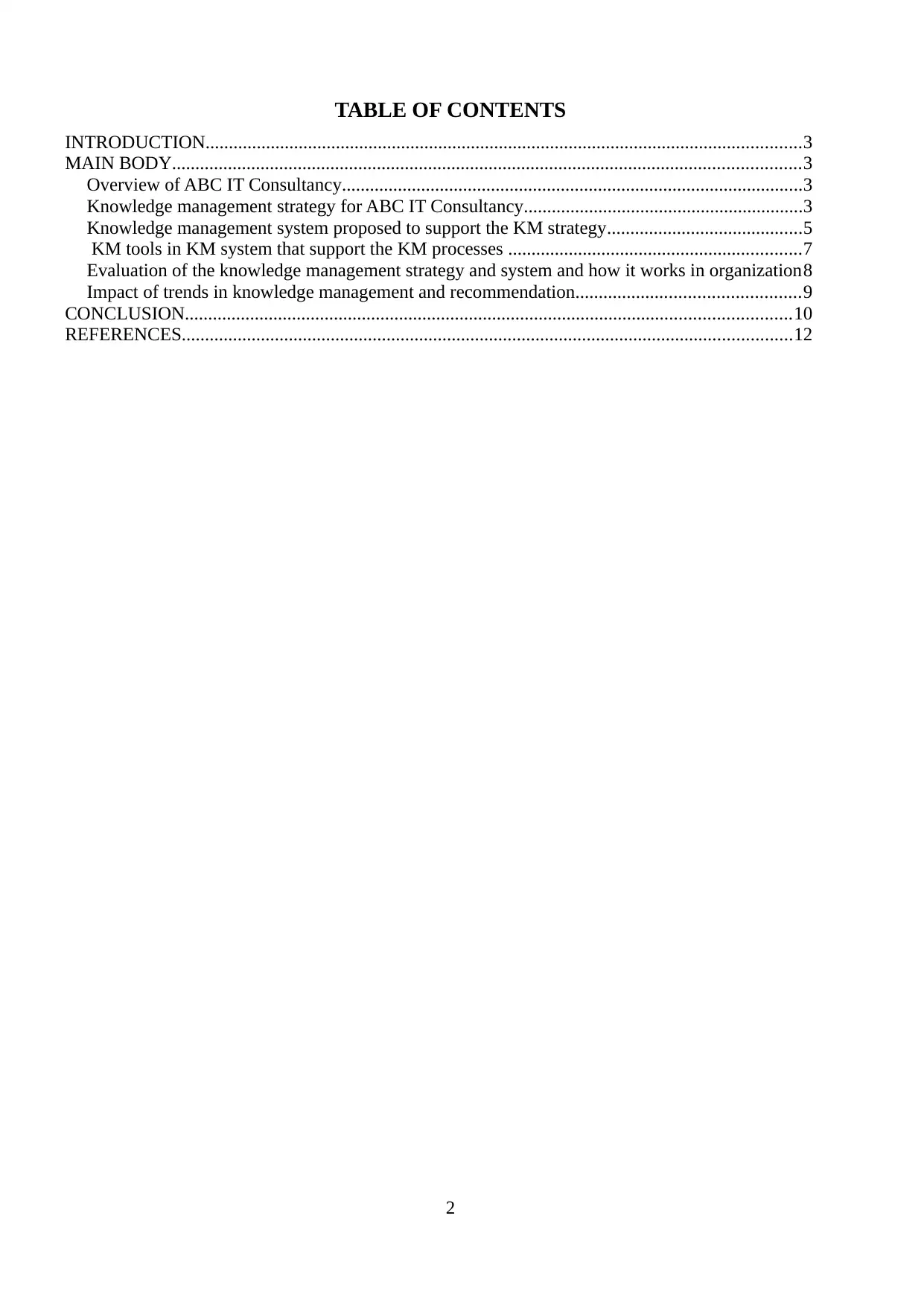
TABLE OF CONTENTS
INTRODUCTION................................................................................................................................3
MAIN BODY.......................................................................................................................................3
Overview of ABC IT Consultancy...................................................................................................3
Knowledge management strategy for ABC IT Consultancy............................................................3
Knowledge management system proposed to support the KM strategy..........................................5
KM tools in KM system that support the KM processes ...............................................................7
Evaluation of the knowledge management strategy and system and how it works in organization8
Impact of trends in knowledge management and recommendation................................................9
CONCLUSION..................................................................................................................................10
REFERENCES...................................................................................................................................12
2
INTRODUCTION................................................................................................................................3
MAIN BODY.......................................................................................................................................3
Overview of ABC IT Consultancy...................................................................................................3
Knowledge management strategy for ABC IT Consultancy............................................................3
Knowledge management system proposed to support the KM strategy..........................................5
KM tools in KM system that support the KM processes ...............................................................7
Evaluation of the knowledge management strategy and system and how it works in organization8
Impact of trends in knowledge management and recommendation................................................9
CONCLUSION..................................................................................................................................10
REFERENCES...................................................................................................................................12
2
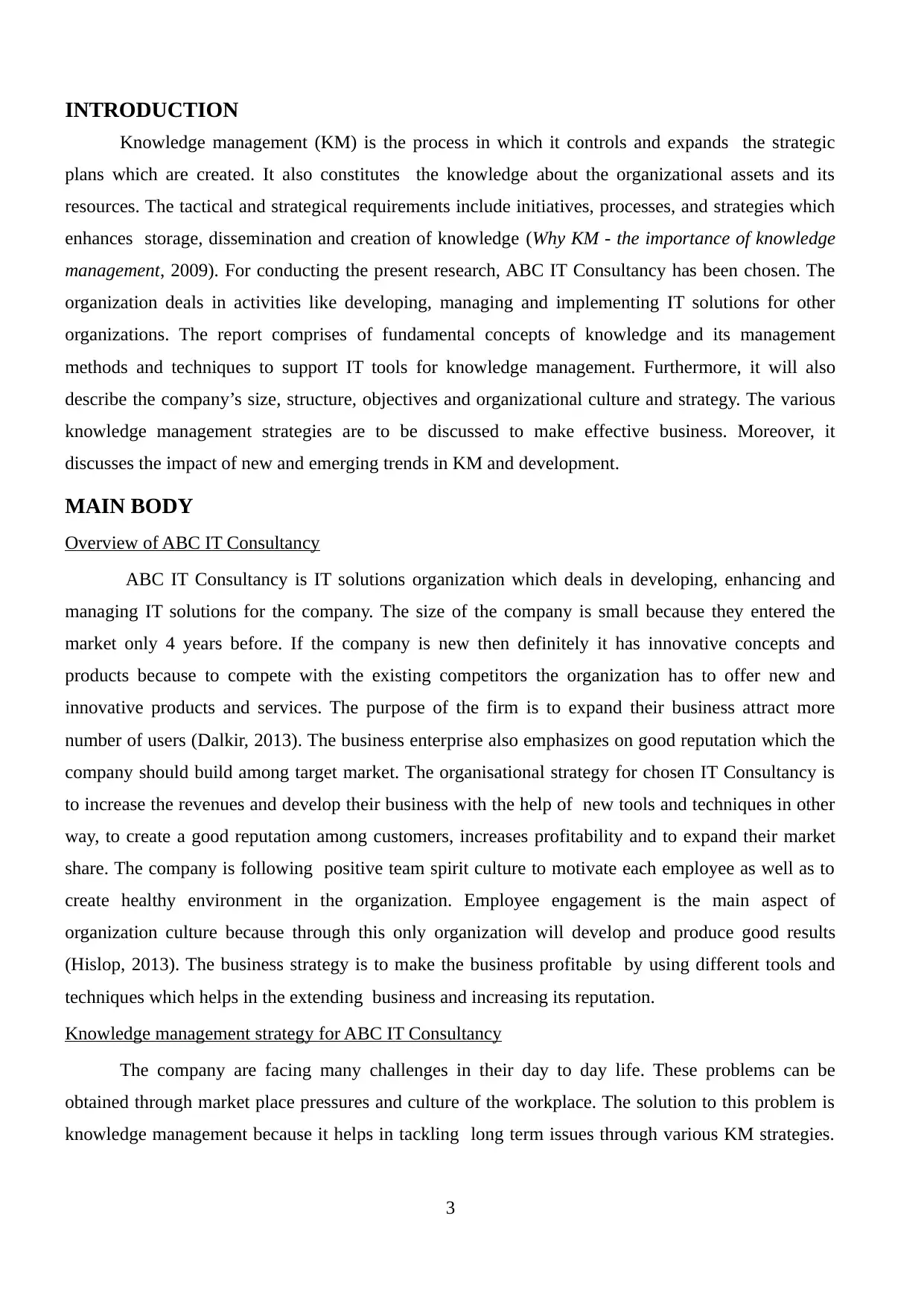
INTRODUCTION
Knowledge management (KM) is the process in which it controls and expands the strategic
plans which are created. It also constitutes the knowledge about the organizational assets and its
resources. The tactical and strategical requirements include initiatives, processes, and strategies which
enhances storage, dissemination and creation of knowledge (Why KM - the importance of knowledge
management, 2009). For conducting the present research, ABC IT Consultancy has been chosen. The
organization deals in activities like developing, managing and implementing IT solutions for other
organizations. The report comprises of fundamental concepts of knowledge and its management
methods and techniques to support IT tools for knowledge management. Furthermore, it will also
describe the company’s size, structure, objectives and organizational culture and strategy. The various
knowledge management strategies are to be discussed to make effective business. Moreover, it
discusses the impact of new and emerging trends in KM and development.
MAIN BODY
Overview of ABC IT Consultancy
ABC IT Consultancy is IT solutions organization which deals in developing, enhancing and
managing IT solutions for the company. The size of the company is small because they entered the
market only 4 years before. If the company is new then definitely it has innovative concepts and
products because to compete with the existing competitors the organization has to offer new and
innovative products and services. The purpose of the firm is to expand their business attract more
number of users (Dalkir, 2013). The business enterprise also emphasizes on good reputation which the
company should build among target market. The organisational strategy for chosen IT Consultancy is
to increase the revenues and develop their business with the help of new tools and techniques in other
way, to create a good reputation among customers, increases profitability and to expand their market
share. The company is following positive team spirit culture to motivate each employee as well as to
create healthy environment in the organization. Employee engagement is the main aspect of
organization culture because through this only organization will develop and produce good results
(Hislop, 2013). The business strategy is to make the business profitable by using different tools and
techniques which helps in the extending business and increasing its reputation.
Knowledge management strategy for ABC IT Consultancy
The company are facing many challenges in their day to day life. These problems can be
obtained through market place pressures and culture of the workplace. The solution to this problem is
knowledge management because it helps in tackling long term issues through various KM strategies.
3
Knowledge management (KM) is the process in which it controls and expands the strategic
plans which are created. It also constitutes the knowledge about the organizational assets and its
resources. The tactical and strategical requirements include initiatives, processes, and strategies which
enhances storage, dissemination and creation of knowledge (Why KM - the importance of knowledge
management, 2009). For conducting the present research, ABC IT Consultancy has been chosen. The
organization deals in activities like developing, managing and implementing IT solutions for other
organizations. The report comprises of fundamental concepts of knowledge and its management
methods and techniques to support IT tools for knowledge management. Furthermore, it will also
describe the company’s size, structure, objectives and organizational culture and strategy. The various
knowledge management strategies are to be discussed to make effective business. Moreover, it
discusses the impact of new and emerging trends in KM and development.
MAIN BODY
Overview of ABC IT Consultancy
ABC IT Consultancy is IT solutions organization which deals in developing, enhancing and
managing IT solutions for the company. The size of the company is small because they entered the
market only 4 years before. If the company is new then definitely it has innovative concepts and
products because to compete with the existing competitors the organization has to offer new and
innovative products and services. The purpose of the firm is to expand their business attract more
number of users (Dalkir, 2013). The business enterprise also emphasizes on good reputation which the
company should build among target market. The organisational strategy for chosen IT Consultancy is
to increase the revenues and develop their business with the help of new tools and techniques in other
way, to create a good reputation among customers, increases profitability and to expand their market
share. The company is following positive team spirit culture to motivate each employee as well as to
create healthy environment in the organization. Employee engagement is the main aspect of
organization culture because through this only organization will develop and produce good results
(Hislop, 2013). The business strategy is to make the business profitable by using different tools and
techniques which helps in the extending business and increasing its reputation.
Knowledge management strategy for ABC IT Consultancy
The company are facing many challenges in their day to day life. These problems can be
obtained through market place pressures and culture of the workplace. The solution to this problem is
knowledge management because it helps in tackling long term issues through various KM strategies.
3
⊘ This is a preview!⊘
Do you want full access?
Subscribe today to unlock all pages.

Trusted by 1+ million students worldwide
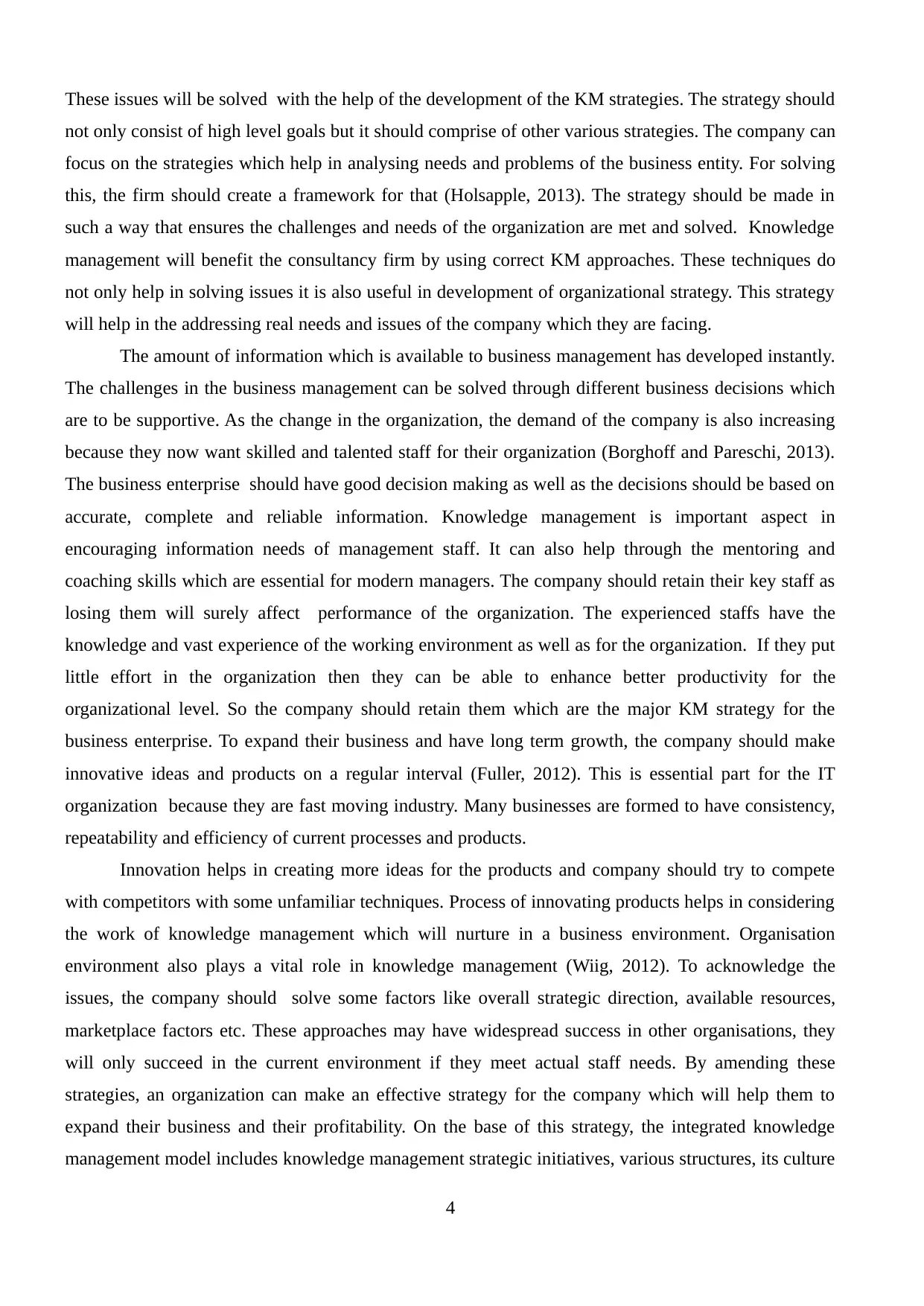
These issues will be solved with the help of the development of the KM strategies. The strategy should
not only consist of high level goals but it should comprise of other various strategies. The company can
focus on the strategies which help in analysing needs and problems of the business entity. For solving
this, the firm should create a framework for that (Holsapple, 2013). The strategy should be made in
such a way that ensures the challenges and needs of the organization are met and solved. Knowledge
management will benefit the consultancy firm by using correct KM approaches. These techniques do
not only help in solving issues it is also useful in development of organizational strategy. This strategy
will help in the addressing real needs and issues of the company which they are facing.
The amount of information which is available to business management has developed instantly.
The challenges in the business management can be solved through different business decisions which
are to be supportive. As the change in the organization, the demand of the company is also increasing
because they now want skilled and talented staff for their organization (Borghoff and Pareschi, 2013).
The business enterprise should have good decision making as well as the decisions should be based on
accurate, complete and reliable information. Knowledge management is important aspect in
encouraging information needs of management staff. It can also help through the mentoring and
coaching skills which are essential for modern managers. The company should retain their key staff as
losing them will surely affect performance of the organization. The experienced staffs have the
knowledge and vast experience of the working environment as well as for the organization. If they put
little effort in the organization then they can be able to enhance better productivity for the
organizational level. So the company should retain them which are the major KM strategy for the
business enterprise. To expand their business and have long term growth, the company should make
innovative ideas and products on a regular interval (Fuller, 2012). This is essential part for the IT
organization because they are fast moving industry. Many businesses are formed to have consistency,
repeatability and efficiency of current processes and products.
Innovation helps in creating more ideas for the products and company should try to compete
with competitors with some unfamiliar techniques. Process of innovating products helps in considering
the work of knowledge management which will nurture in a business environment. Organisation
environment also plays a vital role in knowledge management (Wiig, 2012). To acknowledge the
issues, the company should solve some factors like overall strategic direction, available resources,
marketplace factors etc. These approaches may have widespread success in other organisations, they
will only succeed in the current environment if they meet actual staff needs. By amending these
strategies, an organization can make an effective strategy for the company which will help them to
expand their business and their profitability. On the base of this strategy, the integrated knowledge
management model includes knowledge management strategic initiatives, various structures, its culture
4
not only consist of high level goals but it should comprise of other various strategies. The company can
focus on the strategies which help in analysing needs and problems of the business entity. For solving
this, the firm should create a framework for that (Holsapple, 2013). The strategy should be made in
such a way that ensures the challenges and needs of the organization are met and solved. Knowledge
management will benefit the consultancy firm by using correct KM approaches. These techniques do
not only help in solving issues it is also useful in development of organizational strategy. This strategy
will help in the addressing real needs and issues of the company which they are facing.
The amount of information which is available to business management has developed instantly.
The challenges in the business management can be solved through different business decisions which
are to be supportive. As the change in the organization, the demand of the company is also increasing
because they now want skilled and talented staff for their organization (Borghoff and Pareschi, 2013).
The business enterprise should have good decision making as well as the decisions should be based on
accurate, complete and reliable information. Knowledge management is important aspect in
encouraging information needs of management staff. It can also help through the mentoring and
coaching skills which are essential for modern managers. The company should retain their key staff as
losing them will surely affect performance of the organization. The experienced staffs have the
knowledge and vast experience of the working environment as well as for the organization. If they put
little effort in the organization then they can be able to enhance better productivity for the
organizational level. So the company should retain them which are the major KM strategy for the
business enterprise. To expand their business and have long term growth, the company should make
innovative ideas and products on a regular interval (Fuller, 2012). This is essential part for the IT
organization because they are fast moving industry. Many businesses are formed to have consistency,
repeatability and efficiency of current processes and products.
Innovation helps in creating more ideas for the products and company should try to compete
with competitors with some unfamiliar techniques. Process of innovating products helps in considering
the work of knowledge management which will nurture in a business environment. Organisation
environment also plays a vital role in knowledge management (Wiig, 2012). To acknowledge the
issues, the company should solve some factors like overall strategic direction, available resources,
marketplace factors etc. These approaches may have widespread success in other organisations, they
will only succeed in the current environment if they meet actual staff needs. By amending these
strategies, an organization can make an effective strategy for the company which will help them to
expand their business and their profitability. On the base of this strategy, the integrated knowledge
management model includes knowledge management strategic initiatives, various structures, its culture
4
Paraphrase This Document
Need a fresh take? Get an instant paraphrase of this document with our AI Paraphraser
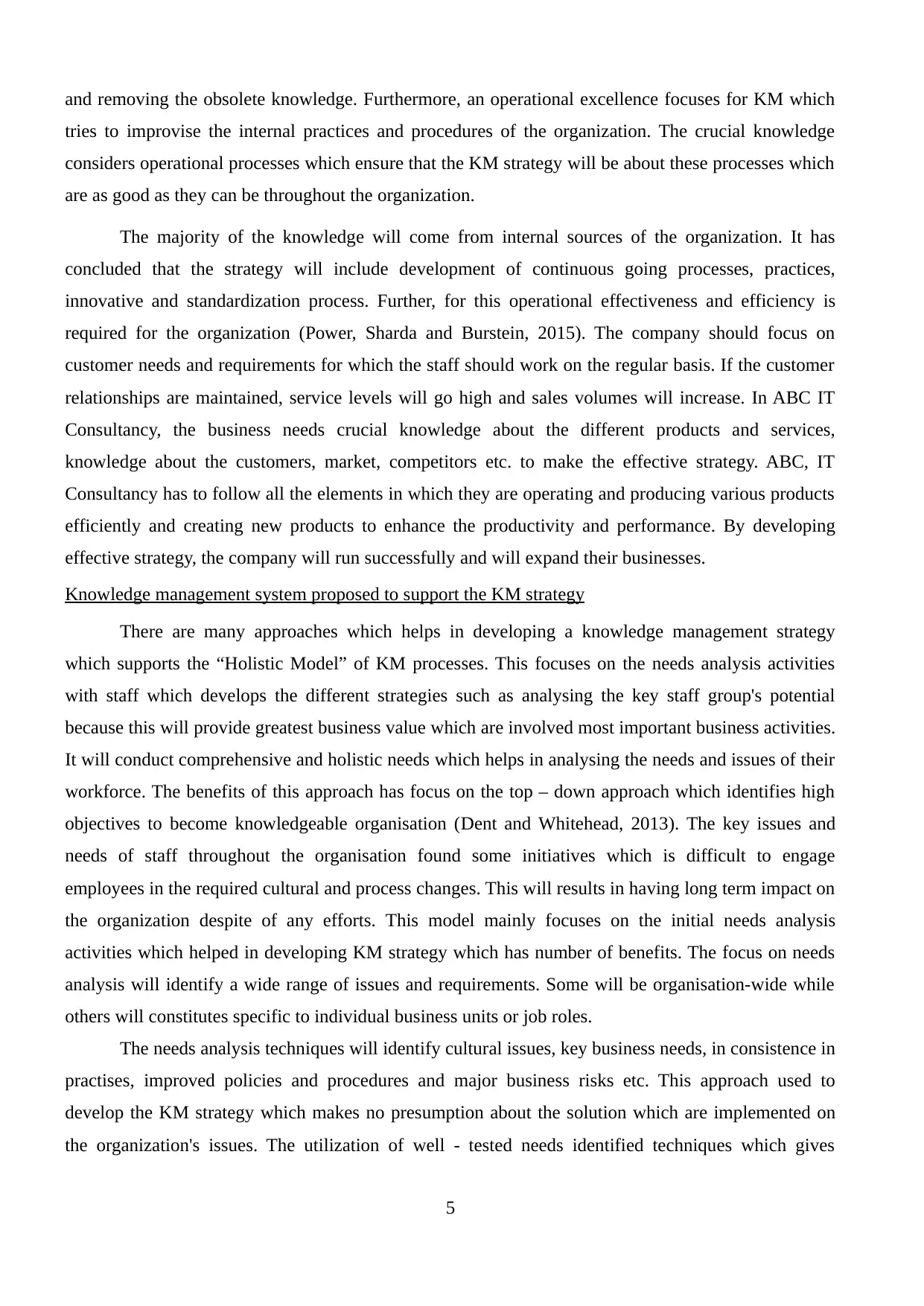
and removing the obsolete knowledge. Furthermore, an operational excellence focuses for KM which
tries to improvise the internal practices and procedures of the organization. The crucial knowledge
considers operational processes which ensure that the KM strategy will be about these processes which
are as good as they can be throughout the organization.
The majority of the knowledge will come from internal sources of the organization. It has
concluded that the strategy will include development of continuous going processes, practices,
innovative and standardization process. Further, for this operational effectiveness and efficiency is
required for the organization (Power, Sharda and Burstein, 2015). The company should focus on
customer needs and requirements for which the staff should work on the regular basis. If the customer
relationships are maintained, service levels will go high and sales volumes will increase. In ABC IT
Consultancy, the business needs crucial knowledge about the different products and services,
knowledge about the customers, market, competitors etc. to make the effective strategy. ABC, IT
Consultancy has to follow all the elements in which they are operating and producing various products
efficiently and creating new products to enhance the productivity and performance. By developing
effective strategy, the company will run successfully and will expand their businesses.
Knowledge management system proposed to support the KM strategy
There are many approaches which helps in developing a knowledge management strategy
which supports the “Holistic Model” of KM processes. This focuses on the needs analysis activities
with staff which develops the different strategies such as analysing the key staff group's potential
because this will provide greatest business value which are involved most important business activities.
It will conduct comprehensive and holistic needs which helps in analysing the needs and issues of their
workforce. The benefits of this approach has focus on the top – down approach which identifies high
objectives to become knowledgeable organisation (Dent and Whitehead, 2013). The key issues and
needs of staff throughout the organisation found some initiatives which is difficult to engage
employees in the required cultural and process changes. This will results in having long term impact on
the organization despite of any efforts. This model mainly focuses on the initial needs analysis
activities which helped in developing KM strategy which has number of benefits. The focus on needs
analysis will identify a wide range of issues and requirements. Some will be organisation-wide while
others will constitutes specific to individual business units or job roles.
The needs analysis techniques will identify cultural issues, key business needs, in consistence in
practises, improved policies and procedures and major business risks etc. This approach used to
develop the KM strategy which makes no presumption about the solution which are implemented on
the organization's issues. The utilization of well - tested needs identified techniques which gives
5
tries to improvise the internal practices and procedures of the organization. The crucial knowledge
considers operational processes which ensure that the KM strategy will be about these processes which
are as good as they can be throughout the organization.
The majority of the knowledge will come from internal sources of the organization. It has
concluded that the strategy will include development of continuous going processes, practices,
innovative and standardization process. Further, for this operational effectiveness and efficiency is
required for the organization (Power, Sharda and Burstein, 2015). The company should focus on
customer needs and requirements for which the staff should work on the regular basis. If the customer
relationships are maintained, service levels will go high and sales volumes will increase. In ABC IT
Consultancy, the business needs crucial knowledge about the different products and services,
knowledge about the customers, market, competitors etc. to make the effective strategy. ABC, IT
Consultancy has to follow all the elements in which they are operating and producing various products
efficiently and creating new products to enhance the productivity and performance. By developing
effective strategy, the company will run successfully and will expand their businesses.
Knowledge management system proposed to support the KM strategy
There are many approaches which helps in developing a knowledge management strategy
which supports the “Holistic Model” of KM processes. This focuses on the needs analysis activities
with staff which develops the different strategies such as analysing the key staff group's potential
because this will provide greatest business value which are involved most important business activities.
It will conduct comprehensive and holistic needs which helps in analysing the needs and issues of their
workforce. The benefits of this approach has focus on the top – down approach which identifies high
objectives to become knowledgeable organisation (Dent and Whitehead, 2013). The key issues and
needs of staff throughout the organisation found some initiatives which is difficult to engage
employees in the required cultural and process changes. This will results in having long term impact on
the organization despite of any efforts. This model mainly focuses on the initial needs analysis
activities which helped in developing KM strategy which has number of benefits. The focus on needs
analysis will identify a wide range of issues and requirements. Some will be organisation-wide while
others will constitutes specific to individual business units or job roles.
The needs analysis techniques will identify cultural issues, key business needs, in consistence in
practises, improved policies and procedures and major business risks etc. This approach used to
develop the KM strategy which makes no presumption about the solution which are implemented on
the organization's issues. The utilization of well - tested needs identified techniques which gives
5
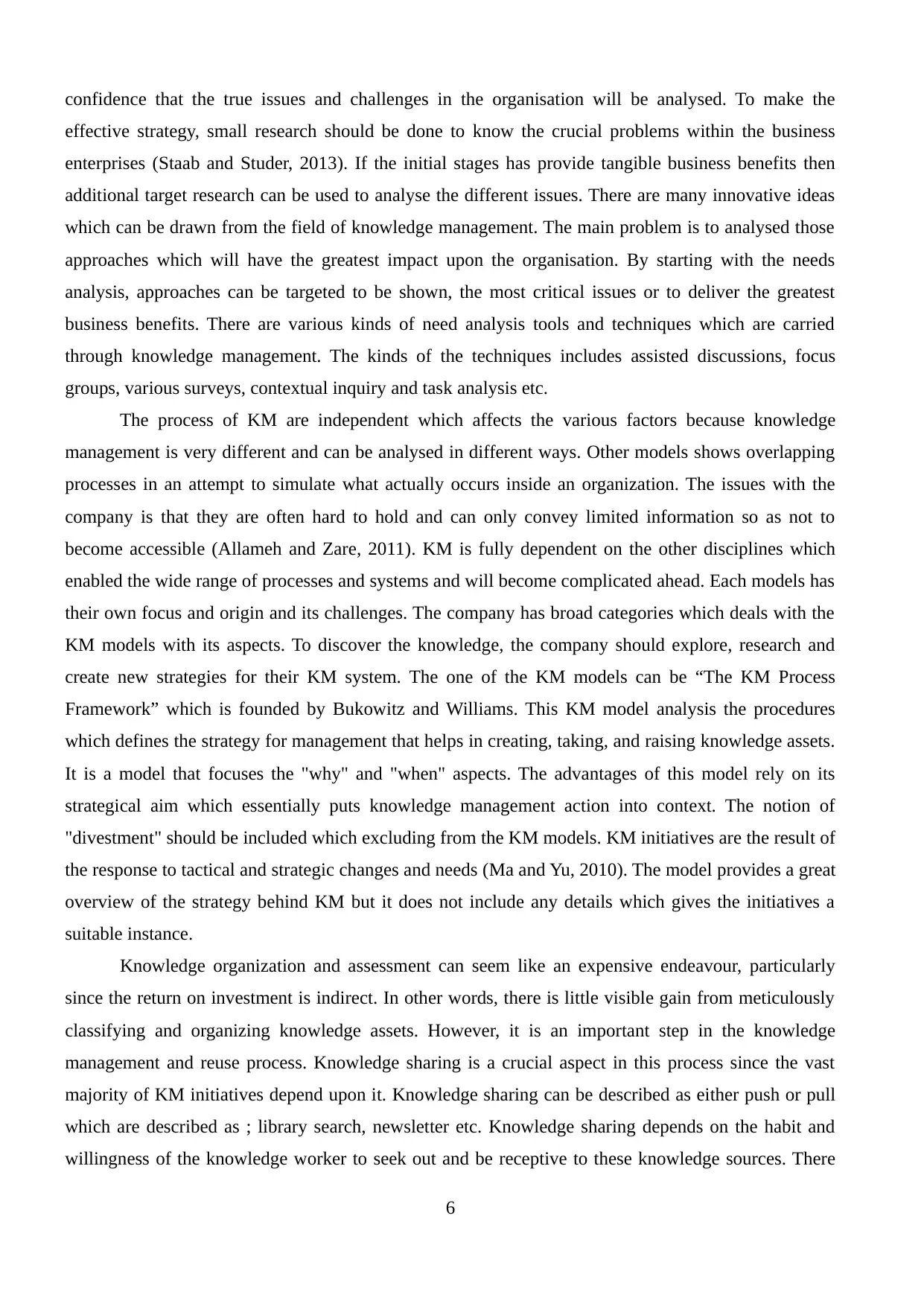
confidence that the true issues and challenges in the organisation will be analysed. To make the
effective strategy, small research should be done to know the crucial problems within the business
enterprises (Staab and Studer, 2013). If the initial stages has provide tangible business benefits then
additional target research can be used to analyse the different issues. There are many innovative ideas
which can be drawn from the field of knowledge management. The main problem is to analysed those
approaches which will have the greatest impact upon the organisation. By starting with the needs
analysis, approaches can be targeted to be shown, the most critical issues or to deliver the greatest
business benefits. There are various kinds of need analysis tools and techniques which are carried
through knowledge management. The kinds of the techniques includes assisted discussions, focus
groups, various surveys, contextual inquiry and task analysis etc.
The process of KM are independent which affects the various factors because knowledge
management is very different and can be analysed in different ways. Other models shows overlapping
processes in an attempt to simulate what actually occurs inside an organization. The issues with the
company is that they are often hard to hold and can only convey limited information so as not to
become accessible (Allameh and Zare, 2011). KM is fully dependent on the other disciplines which
enabled the wide range of processes and systems and will become complicated ahead. Each models has
their own focus and origin and its challenges. The company has broad categories which deals with the
KM models with its aspects. To discover the knowledge, the company should explore, research and
create new strategies for their KM system. The one of the KM models can be “The KM Process
Framework” which is founded by Bukowitz and Williams. This KM model analysis the procedures
which defines the strategy for management that helps in creating, taking, and raising knowledge assets.
It is a model that focuses the "why" and "when" aspects. The advantages of this model rely on its
strategical aim which essentially puts knowledge management action into context. The notion of
"divestment" should be included which excluding from the KM models. KM initiatives are the result of
the response to tactical and strategic changes and needs (Ma and Yu, 2010). The model provides a great
overview of the strategy behind KM but it does not include any details which gives the initiatives a
suitable instance.
Knowledge organization and assessment can seem like an expensive endeavour, particularly
since the return on investment is indirect. In other words, there is little visible gain from meticulously
classifying and organizing knowledge assets. However, it is an important step in the knowledge
management and reuse process. Knowledge sharing is a crucial aspect in this process since the vast
majority of KM initiatives depend upon it. Knowledge sharing can be described as either push or pull
which are described as ; library search, newsletter etc. Knowledge sharing depends on the habit and
willingness of the knowledge worker to seek out and be receptive to these knowledge sources. There
6
effective strategy, small research should be done to know the crucial problems within the business
enterprises (Staab and Studer, 2013). If the initial stages has provide tangible business benefits then
additional target research can be used to analyse the different issues. There are many innovative ideas
which can be drawn from the field of knowledge management. The main problem is to analysed those
approaches which will have the greatest impact upon the organisation. By starting with the needs
analysis, approaches can be targeted to be shown, the most critical issues or to deliver the greatest
business benefits. There are various kinds of need analysis tools and techniques which are carried
through knowledge management. The kinds of the techniques includes assisted discussions, focus
groups, various surveys, contextual inquiry and task analysis etc.
The process of KM are independent which affects the various factors because knowledge
management is very different and can be analysed in different ways. Other models shows overlapping
processes in an attempt to simulate what actually occurs inside an organization. The issues with the
company is that they are often hard to hold and can only convey limited information so as not to
become accessible (Allameh and Zare, 2011). KM is fully dependent on the other disciplines which
enabled the wide range of processes and systems and will become complicated ahead. Each models has
their own focus and origin and its challenges. The company has broad categories which deals with the
KM models with its aspects. To discover the knowledge, the company should explore, research and
create new strategies for their KM system. The one of the KM models can be “The KM Process
Framework” which is founded by Bukowitz and Williams. This KM model analysis the procedures
which defines the strategy for management that helps in creating, taking, and raising knowledge assets.
It is a model that focuses the "why" and "when" aspects. The advantages of this model rely on its
strategical aim which essentially puts knowledge management action into context. The notion of
"divestment" should be included which excluding from the KM models. KM initiatives are the result of
the response to tactical and strategic changes and needs (Ma and Yu, 2010). The model provides a great
overview of the strategy behind KM but it does not include any details which gives the initiatives a
suitable instance.
Knowledge organization and assessment can seem like an expensive endeavour, particularly
since the return on investment is indirect. In other words, there is little visible gain from meticulously
classifying and organizing knowledge assets. However, it is an important step in the knowledge
management and reuse process. Knowledge sharing is a crucial aspect in this process since the vast
majority of KM initiatives depend upon it. Knowledge sharing can be described as either push or pull
which are described as ; library search, newsletter etc. Knowledge sharing depends on the habit and
willingness of the knowledge worker to seek out and be receptive to these knowledge sources. There
6
⊘ This is a preview!⊘
Do you want full access?
Subscribe today to unlock all pages.

Trusted by 1+ million students worldwide
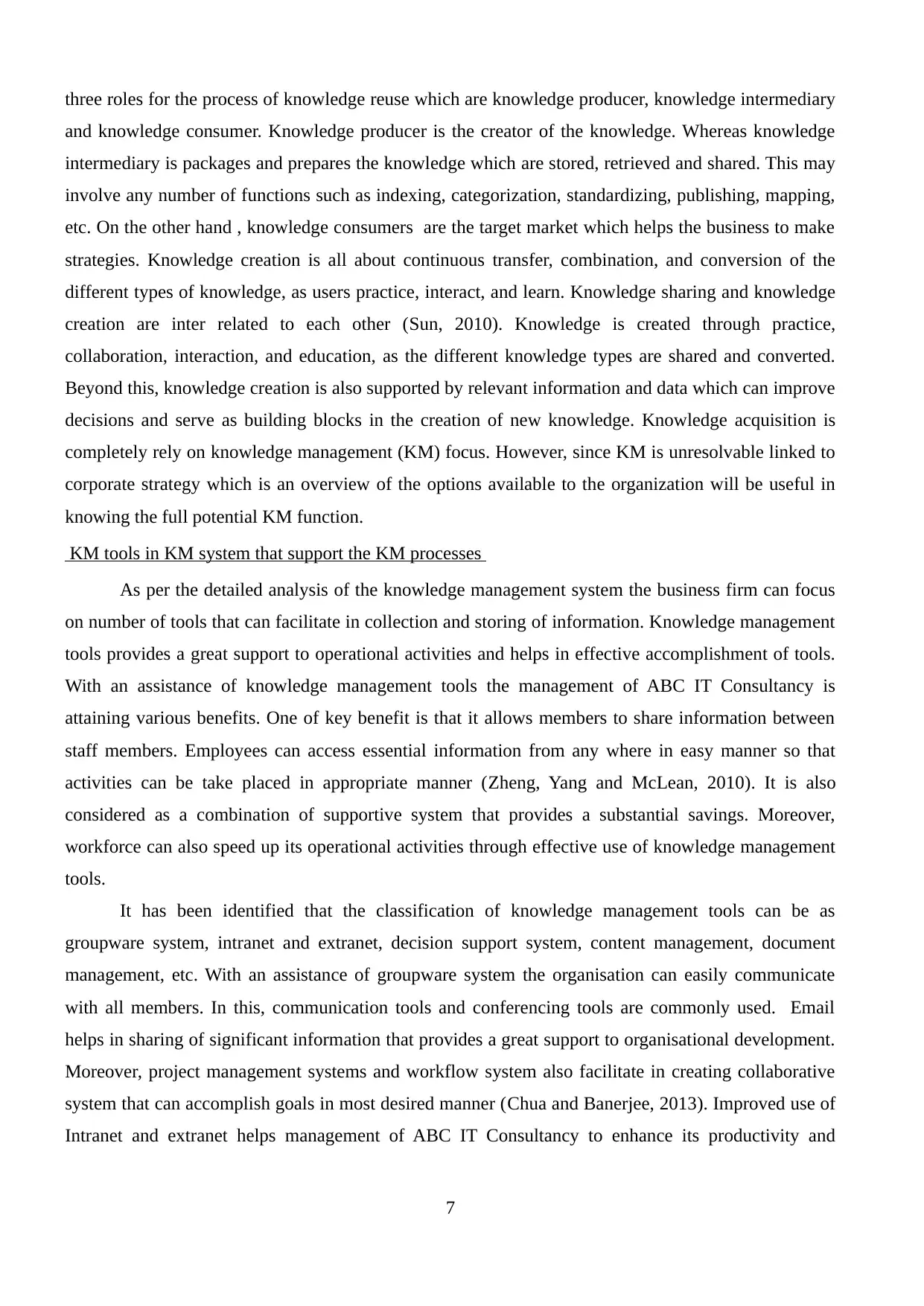
three roles for the process of knowledge reuse which are knowledge producer, knowledge intermediary
and knowledge consumer. Knowledge producer is the creator of the knowledge. Whereas knowledge
intermediary is packages and prepares the knowledge which are stored, retrieved and shared. This may
involve any number of functions such as indexing, categorization, standardizing, publishing, mapping,
etc. On the other hand , knowledge consumers are the target market which helps the business to make
strategies. Knowledge creation is all about continuous transfer, combination, and conversion of the
different types of knowledge, as users practice, interact, and learn. Knowledge sharing and knowledge
creation are inter related to each other (Sun, 2010). Knowledge is created through practice,
collaboration, interaction, and education, as the different knowledge types are shared and converted.
Beyond this, knowledge creation is also supported by relevant information and data which can improve
decisions and serve as building blocks in the creation of new knowledge. Knowledge acquisition is
completely rely on knowledge management (KM) focus. However, since KM is unresolvable linked to
corporate strategy which is an overview of the options available to the organization will be useful in
knowing the full potential KM function.
KM tools in KM system that support the KM processes
As per the detailed analysis of the knowledge management system the business firm can focus
on number of tools that can facilitate in collection and storing of information. Knowledge management
tools provides a great support to operational activities and helps in effective accomplishment of tools.
With an assistance of knowledge management tools the management of ABC IT Consultancy is
attaining various benefits. One of key benefit is that it allows members to share information between
staff members. Employees can access essential information from any where in easy manner so that
activities can be take placed in appropriate manner (Zheng, Yang and McLean, 2010). It is also
considered as a combination of supportive system that provides a substantial savings. Moreover,
workforce can also speed up its operational activities through effective use of knowledge management
tools.
It has been identified that the classification of knowledge management tools can be as
groupware system, intranet and extranet, decision support system, content management, document
management, etc. With an assistance of groupware system the organisation can easily communicate
with all members. In this, communication tools and conferencing tools are commonly used. Email
helps in sharing of significant information that provides a great support to organisational development.
Moreover, project management systems and workflow system also facilitate in creating collaborative
system that can accomplish goals in most desired manner (Chua and Banerjee, 2013). Improved use of
Intranet and extranet helps management of ABC IT Consultancy to enhance its productivity and
7
and knowledge consumer. Knowledge producer is the creator of the knowledge. Whereas knowledge
intermediary is packages and prepares the knowledge which are stored, retrieved and shared. This may
involve any number of functions such as indexing, categorization, standardizing, publishing, mapping,
etc. On the other hand , knowledge consumers are the target market which helps the business to make
strategies. Knowledge creation is all about continuous transfer, combination, and conversion of the
different types of knowledge, as users practice, interact, and learn. Knowledge sharing and knowledge
creation are inter related to each other (Sun, 2010). Knowledge is created through practice,
collaboration, interaction, and education, as the different knowledge types are shared and converted.
Beyond this, knowledge creation is also supported by relevant information and data which can improve
decisions and serve as building blocks in the creation of new knowledge. Knowledge acquisition is
completely rely on knowledge management (KM) focus. However, since KM is unresolvable linked to
corporate strategy which is an overview of the options available to the organization will be useful in
knowing the full potential KM function.
KM tools in KM system that support the KM processes
As per the detailed analysis of the knowledge management system the business firm can focus
on number of tools that can facilitate in collection and storing of information. Knowledge management
tools provides a great support to operational activities and helps in effective accomplishment of tools.
With an assistance of knowledge management tools the management of ABC IT Consultancy is
attaining various benefits. One of key benefit is that it allows members to share information between
staff members. Employees can access essential information from any where in easy manner so that
activities can be take placed in appropriate manner (Zheng, Yang and McLean, 2010). It is also
considered as a combination of supportive system that provides a substantial savings. Moreover,
workforce can also speed up its operational activities through effective use of knowledge management
tools.
It has been identified that the classification of knowledge management tools can be as
groupware system, intranet and extranet, decision support system, content management, document
management, etc. With an assistance of groupware system the organisation can easily communicate
with all members. In this, communication tools and conferencing tools are commonly used. Email
helps in sharing of significant information that provides a great support to organisational development.
Moreover, project management systems and workflow system also facilitate in creating collaborative
system that can accomplish goals in most desired manner (Chua and Banerjee, 2013). Improved use of
Intranet and extranet helps management of ABC IT Consultancy to enhance its productivity and
7
Paraphrase This Document
Need a fresh take? Get an instant paraphrase of this document with our AI Paraphraser
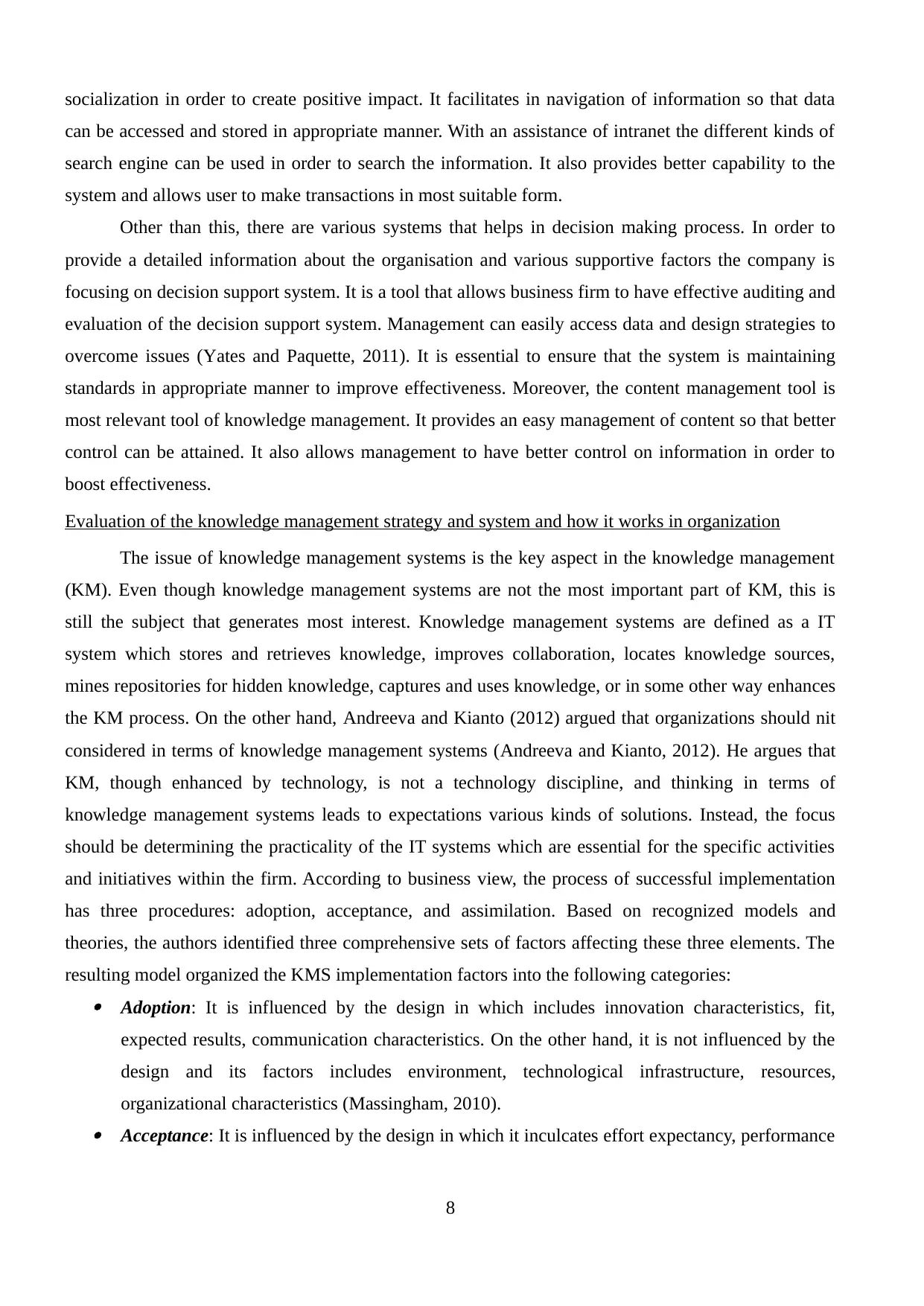
socialization in order to create positive impact. It facilitates in navigation of information so that data
can be accessed and stored in appropriate manner. With an assistance of intranet the different kinds of
search engine can be used in order to search the information. It also provides better capability to the
system and allows user to make transactions in most suitable form.
Other than this, there are various systems that helps in decision making process. In order to
provide a detailed information about the organisation and various supportive factors the company is
focusing on decision support system. It is a tool that allows business firm to have effective auditing and
evaluation of the decision support system. Management can easily access data and design strategies to
overcome issues (Yates and Paquette, 2011). It is essential to ensure that the system is maintaining
standards in appropriate manner to improve effectiveness. Moreover, the content management tool is
most relevant tool of knowledge management. It provides an easy management of content so that better
control can be attained. It also allows management to have better control on information in order to
boost effectiveness.
Evaluation of the knowledge management strategy and system and how it works in organization
The issue of knowledge management systems is the key aspect in the knowledge management
(KM). Even though knowledge management systems are not the most important part of KM, this is
still the subject that generates most interest. Knowledge management systems are defined as a IT
system which stores and retrieves knowledge, improves collaboration, locates knowledge sources,
mines repositories for hidden knowledge, captures and uses knowledge, or in some other way enhances
the KM process. On the other hand, Andreeva and Kianto (2012) argued that organizations should nit
considered in terms of knowledge management systems (Andreeva and Kianto, 2012). He argues that
KM, though enhanced by technology, is not a technology discipline, and thinking in terms of
knowledge management systems leads to expectations various kinds of solutions. Instead, the focus
should be determining the practicality of the IT systems which are essential for the specific activities
and initiatives within the firm. According to business view, the process of successful implementation
has three procedures: adoption, acceptance, and assimilation. Based on recognized models and
theories, the authors identified three comprehensive sets of factors affecting these three elements. The
resulting model organized the KMS implementation factors into the following categories: Adoption: It is influenced by the design in which includes innovation characteristics, fit,
expected results, communication characteristics. On the other hand, it is not influenced by the
design and its factors includes environment, technological infrastructure, resources,
organizational characteristics (Massingham, 2010). Acceptance: It is influenced by the design in which it inculcates effort expectancy, performance
8
can be accessed and stored in appropriate manner. With an assistance of intranet the different kinds of
search engine can be used in order to search the information. It also provides better capability to the
system and allows user to make transactions in most suitable form.
Other than this, there are various systems that helps in decision making process. In order to
provide a detailed information about the organisation and various supportive factors the company is
focusing on decision support system. It is a tool that allows business firm to have effective auditing and
evaluation of the decision support system. Management can easily access data and design strategies to
overcome issues (Yates and Paquette, 2011). It is essential to ensure that the system is maintaining
standards in appropriate manner to improve effectiveness. Moreover, the content management tool is
most relevant tool of knowledge management. It provides an easy management of content so that better
control can be attained. It also allows management to have better control on information in order to
boost effectiveness.
Evaluation of the knowledge management strategy and system and how it works in organization
The issue of knowledge management systems is the key aspect in the knowledge management
(KM). Even though knowledge management systems are not the most important part of KM, this is
still the subject that generates most interest. Knowledge management systems are defined as a IT
system which stores and retrieves knowledge, improves collaboration, locates knowledge sources,
mines repositories for hidden knowledge, captures and uses knowledge, or in some other way enhances
the KM process. On the other hand, Andreeva and Kianto (2012) argued that organizations should nit
considered in terms of knowledge management systems (Andreeva and Kianto, 2012). He argues that
KM, though enhanced by technology, is not a technology discipline, and thinking in terms of
knowledge management systems leads to expectations various kinds of solutions. Instead, the focus
should be determining the practicality of the IT systems which are essential for the specific activities
and initiatives within the firm. According to business view, the process of successful implementation
has three procedures: adoption, acceptance, and assimilation. Based on recognized models and
theories, the authors identified three comprehensive sets of factors affecting these three elements. The
resulting model organized the KMS implementation factors into the following categories: Adoption: It is influenced by the design in which includes innovation characteristics, fit,
expected results, communication characteristics. On the other hand, it is not influenced by the
design and its factors includes environment, technological infrastructure, resources,
organizational characteristics (Massingham, 2010). Acceptance: It is influenced by the design in which it inculcates effort expectancy, performance
8
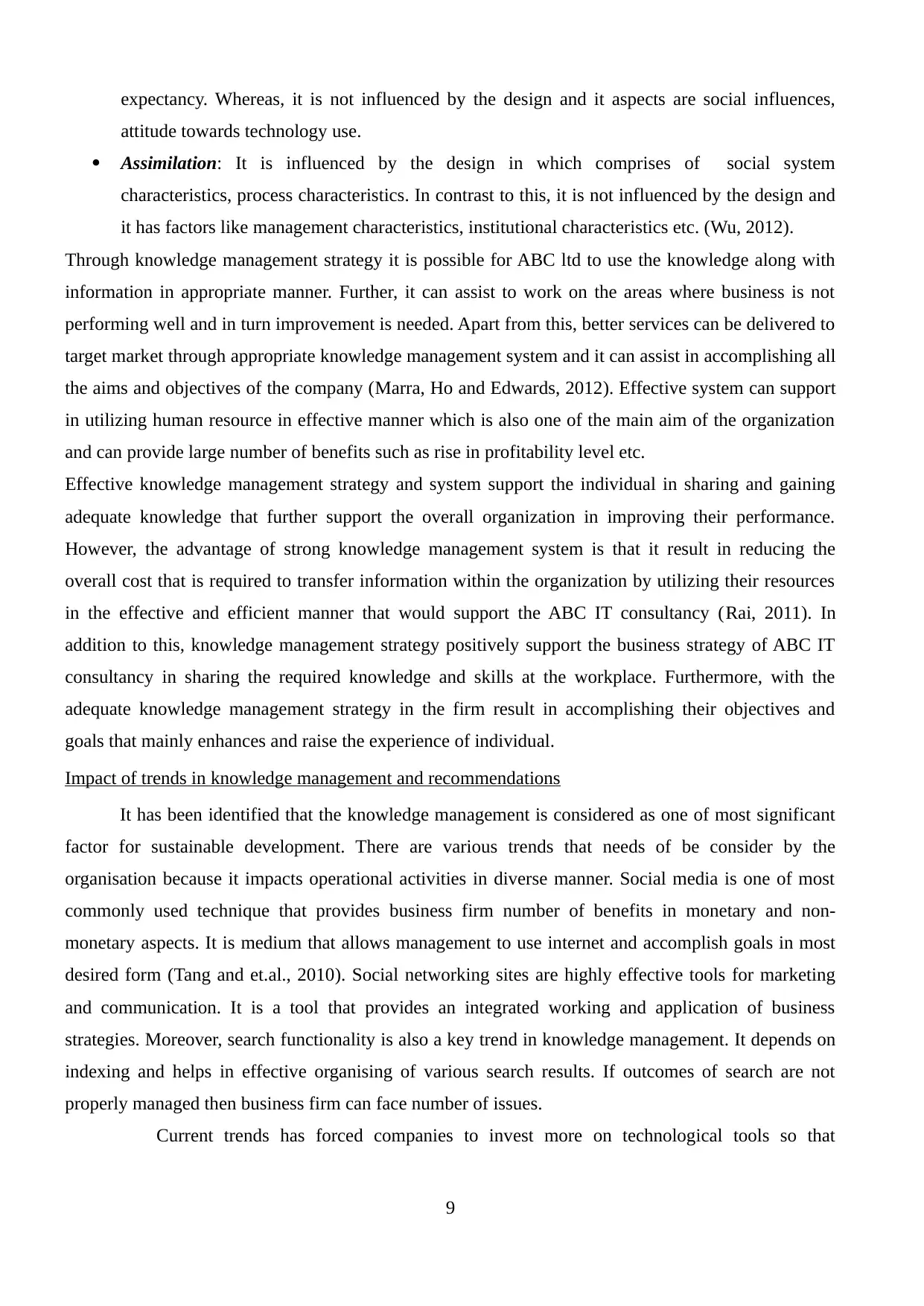
expectancy. Whereas, it is not influenced by the design and it aspects are social influences,
attitude towards technology use.
Assimilation: It is influenced by the design in which comprises of social system
characteristics, process characteristics. In contrast to this, it is not influenced by the design and
it has factors like management characteristics, institutional characteristics etc. (Wu, 2012).
Through knowledge management strategy it is possible for ABC ltd to use the knowledge along with
information in appropriate manner. Further, it can assist to work on the areas where business is not
performing well and in turn improvement is needed. Apart from this, better services can be delivered to
target market through appropriate knowledge management system and it can assist in accomplishing all
the aims and objectives of the company (Marra, Ho and Edwards, 2012). Effective system can support
in utilizing human resource in effective manner which is also one of the main aim of the organization
and can provide large number of benefits such as rise in profitability level etc.
Effective knowledge management strategy and system support the individual in sharing and gaining
adequate knowledge that further support the overall organization in improving their performance.
However, the advantage of strong knowledge management system is that it result in reducing the
overall cost that is required to transfer information within the organization by utilizing their resources
in the effective and efficient manner that would support the ABC IT consultancy (Rai, 2011). In
addition to this, knowledge management strategy positively support the business strategy of ABC IT
consultancy in sharing the required knowledge and skills at the workplace. Furthermore, with the
adequate knowledge management strategy in the firm result in accomplishing their objectives and
goals that mainly enhances and raise the experience of individual.
Impact of trends in knowledge management and recommendations
It has been identified that the knowledge management is considered as one of most significant
factor for sustainable development. There are various trends that needs of be consider by the
organisation because it impacts operational activities in diverse manner. Social media is one of most
commonly used technique that provides business firm number of benefits in monetary and non-
monetary aspects. It is medium that allows management to use internet and accomplish goals in most
desired form (Tang and et.al., 2010). Social networking sites are highly effective tools for marketing
and communication. It is a tool that provides an integrated working and application of business
strategies. Moreover, search functionality is also a key trend in knowledge management. It depends on
indexing and helps in effective organising of various search results. If outcomes of search are not
properly managed then business firm can face number of issues.
Current trends has forced companies to invest more on technological tools so that
9
attitude towards technology use.
Assimilation: It is influenced by the design in which comprises of social system
characteristics, process characteristics. In contrast to this, it is not influenced by the design and
it has factors like management characteristics, institutional characteristics etc. (Wu, 2012).
Through knowledge management strategy it is possible for ABC ltd to use the knowledge along with
information in appropriate manner. Further, it can assist to work on the areas where business is not
performing well and in turn improvement is needed. Apart from this, better services can be delivered to
target market through appropriate knowledge management system and it can assist in accomplishing all
the aims and objectives of the company (Marra, Ho and Edwards, 2012). Effective system can support
in utilizing human resource in effective manner which is also one of the main aim of the organization
and can provide large number of benefits such as rise in profitability level etc.
Effective knowledge management strategy and system support the individual in sharing and gaining
adequate knowledge that further support the overall organization in improving their performance.
However, the advantage of strong knowledge management system is that it result in reducing the
overall cost that is required to transfer information within the organization by utilizing their resources
in the effective and efficient manner that would support the ABC IT consultancy (Rai, 2011). In
addition to this, knowledge management strategy positively support the business strategy of ABC IT
consultancy in sharing the required knowledge and skills at the workplace. Furthermore, with the
adequate knowledge management strategy in the firm result in accomplishing their objectives and
goals that mainly enhances and raise the experience of individual.
Impact of trends in knowledge management and recommendations
It has been identified that the knowledge management is considered as one of most significant
factor for sustainable development. There are various trends that needs of be consider by the
organisation because it impacts operational activities in diverse manner. Social media is one of most
commonly used technique that provides business firm number of benefits in monetary and non-
monetary aspects. It is medium that allows management to use internet and accomplish goals in most
desired form (Tang and et.al., 2010). Social networking sites are highly effective tools for marketing
and communication. It is a tool that provides an integrated working and application of business
strategies. Moreover, search functionality is also a key trend in knowledge management. It depends on
indexing and helps in effective organising of various search results. If outcomes of search are not
properly managed then business firm can face number of issues.
Current trends has forced companies to invest more on technological tools so that
9
⊘ This is a preview!⊘
Do you want full access?
Subscribe today to unlock all pages.

Trusted by 1+ million students worldwide
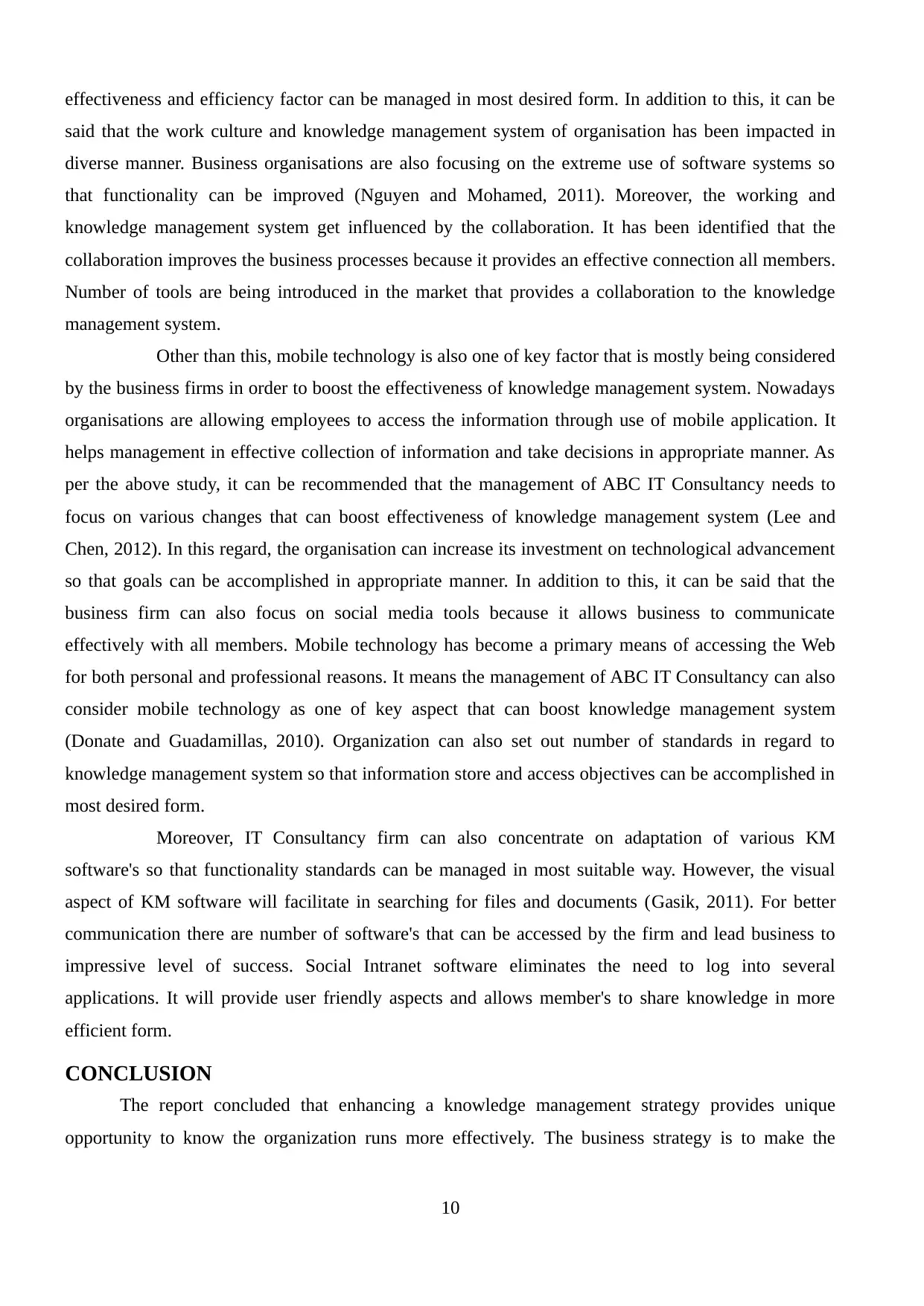
effectiveness and efficiency factor can be managed in most desired form. In addition to this, it can be
said that the work culture and knowledge management system of organisation has been impacted in
diverse manner. Business organisations are also focusing on the extreme use of software systems so
that functionality can be improved (Nguyen and Mohamed, 2011). Moreover, the working and
knowledge management system get influenced by the collaboration. It has been identified that the
collaboration improves the business processes because it provides an effective connection all members.
Number of tools are being introduced in the market that provides a collaboration to the knowledge
management system.
Other than this, mobile technology is also one of key factor that is mostly being considered
by the business firms in order to boost the effectiveness of knowledge management system. Nowadays
organisations are allowing employees to access the information through use of mobile application. It
helps management in effective collection of information and take decisions in appropriate manner. As
per the above study, it can be recommended that the management of ABC IT Consultancy needs to
focus on various changes that can boost effectiveness of knowledge management system (Lee and
Chen, 2012). In this regard, the organisation can increase its investment on technological advancement
so that goals can be accomplished in appropriate manner. In addition to this, it can be said that the
business firm can also focus on social media tools because it allows business to communicate
effectively with all members. Mobile technology has become a primary means of accessing the Web
for both personal and professional reasons. It means the management of ABC IT Consultancy can also
consider mobile technology as one of key aspect that can boost knowledge management system
(Donate and Guadamillas, 2010). Organization can also set out number of standards in regard to
knowledge management system so that information store and access objectives can be accomplished in
most desired form.
Moreover, IT Consultancy firm can also concentrate on adaptation of various KM
software's so that functionality standards can be managed in most suitable way. However, the visual
aspect of KM software will facilitate in searching for files and documents (Gasik, 2011). For better
communication there are number of software's that can be accessed by the firm and lead business to
impressive level of success. Social Intranet software eliminates the need to log into several
applications. It will provide user friendly aspects and allows member's to share knowledge in more
efficient form.
CONCLUSION
The report concluded that enhancing a knowledge management strategy provides unique
opportunity to know the organization runs more effectively. The business strategy is to make the
10
said that the work culture and knowledge management system of organisation has been impacted in
diverse manner. Business organisations are also focusing on the extreme use of software systems so
that functionality can be improved (Nguyen and Mohamed, 2011). Moreover, the working and
knowledge management system get influenced by the collaboration. It has been identified that the
collaboration improves the business processes because it provides an effective connection all members.
Number of tools are being introduced in the market that provides a collaboration to the knowledge
management system.
Other than this, mobile technology is also one of key factor that is mostly being considered
by the business firms in order to boost the effectiveness of knowledge management system. Nowadays
organisations are allowing employees to access the information through use of mobile application. It
helps management in effective collection of information and take decisions in appropriate manner. As
per the above study, it can be recommended that the management of ABC IT Consultancy needs to
focus on various changes that can boost effectiveness of knowledge management system (Lee and
Chen, 2012). In this regard, the organisation can increase its investment on technological advancement
so that goals can be accomplished in appropriate manner. In addition to this, it can be said that the
business firm can also focus on social media tools because it allows business to communicate
effectively with all members. Mobile technology has become a primary means of accessing the Web
for both personal and professional reasons. It means the management of ABC IT Consultancy can also
consider mobile technology as one of key aspect that can boost knowledge management system
(Donate and Guadamillas, 2010). Organization can also set out number of standards in regard to
knowledge management system so that information store and access objectives can be accomplished in
most desired form.
Moreover, IT Consultancy firm can also concentrate on adaptation of various KM
software's so that functionality standards can be managed in most suitable way. However, the visual
aspect of KM software will facilitate in searching for files and documents (Gasik, 2011). For better
communication there are number of software's that can be accessed by the firm and lead business to
impressive level of success. Social Intranet software eliminates the need to log into several
applications. It will provide user friendly aspects and allows member's to share knowledge in more
efficient form.
CONCLUSION
The report concluded that enhancing a knowledge management strategy provides unique
opportunity to know the organization runs more effectively. The business strategy is to make the
10
Paraphrase This Document
Need a fresh take? Get an instant paraphrase of this document with our AI Paraphraser
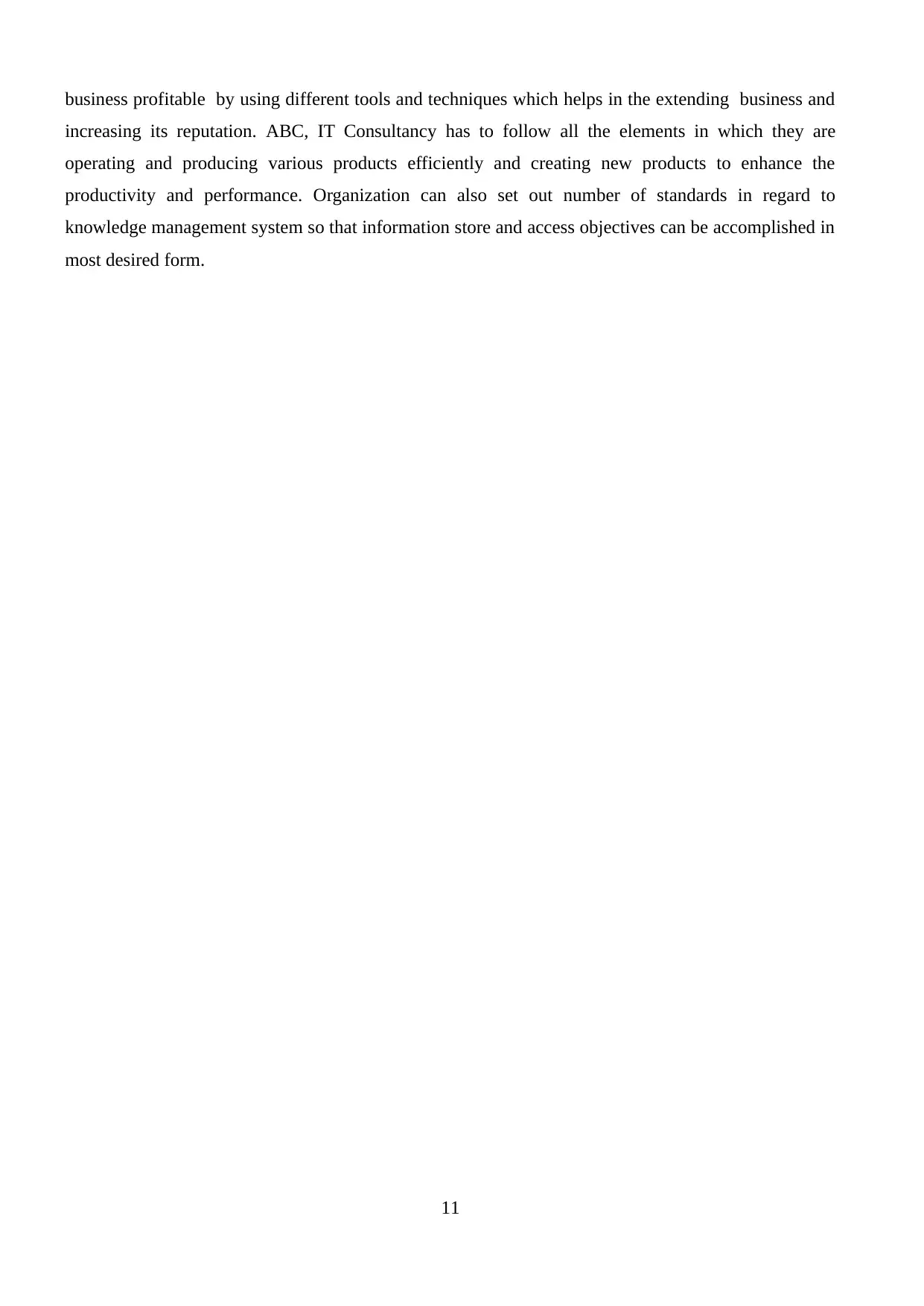
business profitable by using different tools and techniques which helps in the extending business and
increasing its reputation. ABC, IT Consultancy has to follow all the elements in which they are
operating and producing various products efficiently and creating new products to enhance the
productivity and performance. Organization can also set out number of standards in regard to
knowledge management system so that information store and access objectives can be accomplished in
most desired form.
11
increasing its reputation. ABC, IT Consultancy has to follow all the elements in which they are
operating and producing various products efficiently and creating new products to enhance the
productivity and performance. Organization can also set out number of standards in regard to
knowledge management system so that information store and access objectives can be accomplished in
most desired form.
11
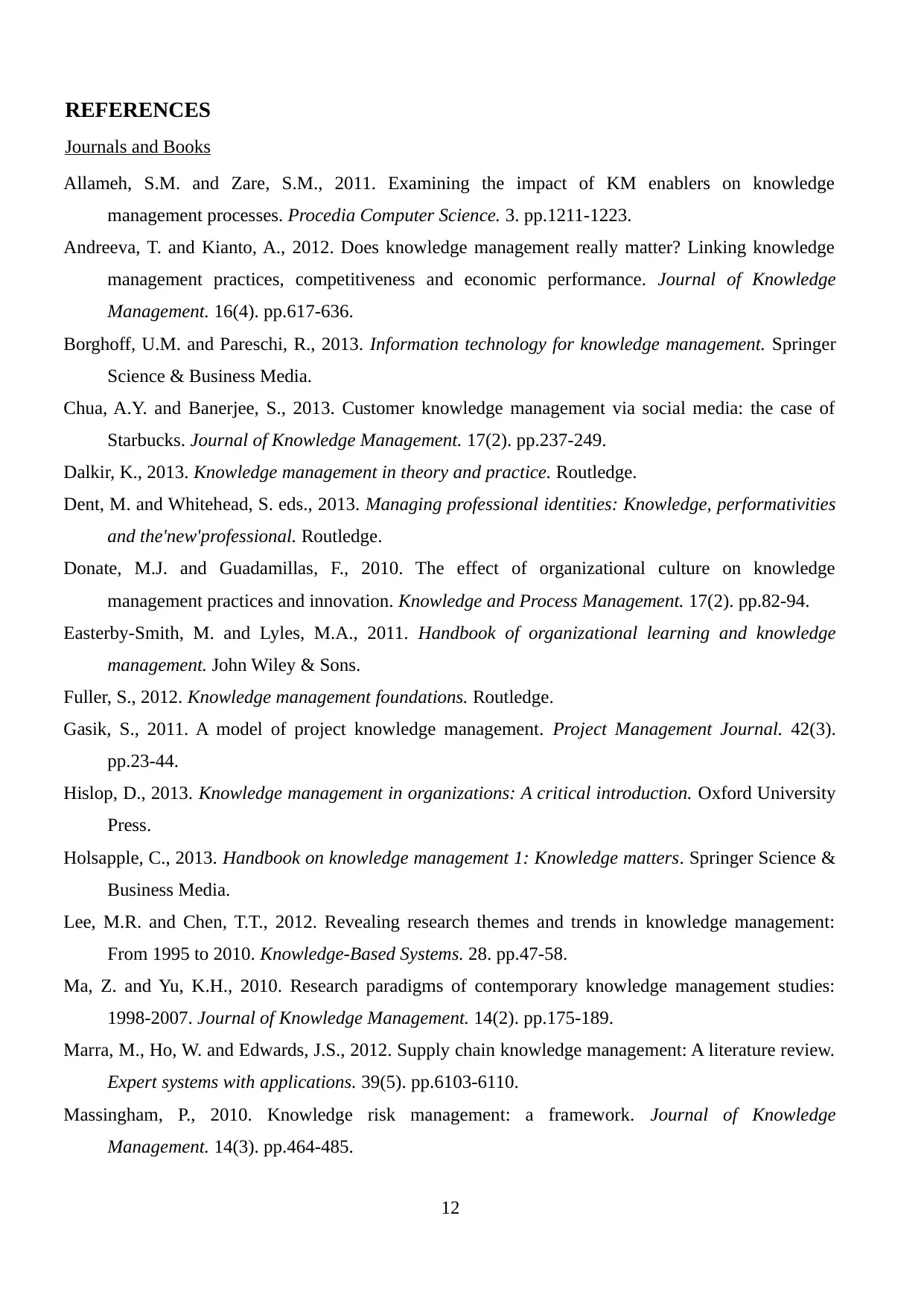
REFERENCES
Journals and Books
Allameh, S.M. and Zare, S.M., 2011. Examining the impact of KM enablers on knowledge
management processes. Procedia Computer Science. 3. pp.1211-1223.
Andreeva, T. and Kianto, A., 2012. Does knowledge management really matter? Linking knowledge
management practices, competitiveness and economic performance. Journal of Knowledge
Management. 16(4). pp.617-636.
Borghoff, U.M. and Pareschi, R., 2013. Information technology for knowledge management. Springer
Science & Business Media.
Chua, A.Y. and Banerjee, S., 2013. Customer knowledge management via social media: the case of
Starbucks. Journal of Knowledge Management. 17(2). pp.237-249.
Dalkir, K., 2013. Knowledge management in theory and practice. Routledge.
Dent, M. and Whitehead, S. eds., 2013. Managing professional identities: Knowledge, performativities
and the'new'professional. Routledge.
Donate, M.J. and Guadamillas, F., 2010. The effect of organizational culture on knowledge
management practices and innovation. Knowledge and Process Management. 17(2). pp.82-94.
Easterby-Smith, M. and Lyles, M.A., 2011. Handbook of organizational learning and knowledge
management. John Wiley & Sons.
Fuller, S., 2012. Knowledge management foundations. Routledge.
Gasik, S., 2011. A model of project knowledge management. Project Management Journal. 42(3).
pp.23-44.
Hislop, D., 2013. Knowledge management in organizations: A critical introduction. Oxford University
Press.
Holsapple, C., 2013. Handbook on knowledge management 1: Knowledge matters. Springer Science &
Business Media.
Lee, M.R. and Chen, T.T., 2012. Revealing research themes and trends in knowledge management:
From 1995 to 2010. Knowledge-Based Systems. 28. pp.47-58.
Ma, Z. and Yu, K.H., 2010. Research paradigms of contemporary knowledge management studies:
1998-2007. Journal of Knowledge Management. 14(2). pp.175-189.
Marra, M., Ho, W. and Edwards, J.S., 2012. Supply chain knowledge management: A literature review.
Expert systems with applications. 39(5). pp.6103-6110.
Massingham, P., 2010. Knowledge risk management: a framework. Journal of Knowledge
Management. 14(3). pp.464-485.
12
Journals and Books
Allameh, S.M. and Zare, S.M., 2011. Examining the impact of KM enablers on knowledge
management processes. Procedia Computer Science. 3. pp.1211-1223.
Andreeva, T. and Kianto, A., 2012. Does knowledge management really matter? Linking knowledge
management practices, competitiveness and economic performance. Journal of Knowledge
Management. 16(4). pp.617-636.
Borghoff, U.M. and Pareschi, R., 2013. Information technology for knowledge management. Springer
Science & Business Media.
Chua, A.Y. and Banerjee, S., 2013. Customer knowledge management via social media: the case of
Starbucks. Journal of Knowledge Management. 17(2). pp.237-249.
Dalkir, K., 2013. Knowledge management in theory and practice. Routledge.
Dent, M. and Whitehead, S. eds., 2013. Managing professional identities: Knowledge, performativities
and the'new'professional. Routledge.
Donate, M.J. and Guadamillas, F., 2010. The effect of organizational culture on knowledge
management practices and innovation. Knowledge and Process Management. 17(2). pp.82-94.
Easterby-Smith, M. and Lyles, M.A., 2011. Handbook of organizational learning and knowledge
management. John Wiley & Sons.
Fuller, S., 2012. Knowledge management foundations. Routledge.
Gasik, S., 2011. A model of project knowledge management. Project Management Journal. 42(3).
pp.23-44.
Hislop, D., 2013. Knowledge management in organizations: A critical introduction. Oxford University
Press.
Holsapple, C., 2013. Handbook on knowledge management 1: Knowledge matters. Springer Science &
Business Media.
Lee, M.R. and Chen, T.T., 2012. Revealing research themes and trends in knowledge management:
From 1995 to 2010. Knowledge-Based Systems. 28. pp.47-58.
Ma, Z. and Yu, K.H., 2010. Research paradigms of contemporary knowledge management studies:
1998-2007. Journal of Knowledge Management. 14(2). pp.175-189.
Marra, M., Ho, W. and Edwards, J.S., 2012. Supply chain knowledge management: A literature review.
Expert systems with applications. 39(5). pp.6103-6110.
Massingham, P., 2010. Knowledge risk management: a framework. Journal of Knowledge
Management. 14(3). pp.464-485.
12
⊘ This is a preview!⊘
Do you want full access?
Subscribe today to unlock all pages.

Trusted by 1+ million students worldwide
1 out of 15
Related Documents
Your All-in-One AI-Powered Toolkit for Academic Success.
+13062052269
info@desklib.com
Available 24*7 on WhatsApp / Email
![[object Object]](/_next/static/media/star-bottom.7253800d.svg)
Unlock your academic potential
Copyright © 2020–2025 A2Z Services. All Rights Reserved. Developed and managed by ZUCOL.




